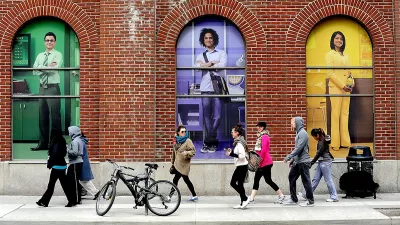Geoff Dyer describes the essential role that a residential component plays in any mixed-use town center. For Dyer, residences are "the substrate on which a healthy mixed-use environment is based."
Why's it so hard for developers to properly value mixing residential in town centers? Perhaps there are still too many barriers in place thanks to government and politics. Dyer considers key advantages to getting over the hurdle, including walkable choice, trip reduction, 24-hour population, a built-in market, transit support, mixed-use integration, horizontal versus vertical mixed-use, and fine-grained urbanism. Then Dyer looks to lessons learned from places that get it right:
"One of my favorite precedents is Habersham in South Carolina by DPZ & Co. and the Habersham Land Company. Located in the middle of nowhere, in a modest economy, and in a location with predominantly low-cost single family homes, Habersham has quietly grown out of the low country swamp to become a fantastic mixed-use, walkable village. Vertically mixed-use live/works with residences over commercial, a variety of row houses, and small apartment houses lining the regional roadway. An example of fine-grained incremental urbanism, Habersham is an important model for the future where large development loans are becoming scarce as the market continues to shift toward walkable mixed-use environments."
Habersham's lessons learned include small lots in the town center for incremental development in an uncertain economy, paying attention to block structure, and flexible zoning. Dyer goes on to address large-scale mixed use in a similar fashion.
Thanks to Hazel Borys
FULL STORY: Get your Multi-Family into a Walkable Town Center!

Planetizen Federal Action Tracker
A weekly monitor of how Trump’s orders and actions are impacting planners and planning in America.

Maui's Vacation Rental Debate Turns Ugly
Verbal attacks, misinformation campaigns and fistfights plague a high-stakes debate to convert thousands of vacation rentals into long-term housing.

Restaurant Patios Were a Pandemic Win — Why Were They so Hard to Keep?
Social distancing requirements and changes in travel patterns prompted cities to pilot new uses for street and sidewalk space. Then it got complicated.

In California Battle of Housing vs. Environment, Housing Just Won
A new state law significantly limits the power of CEQA, an environmental review law that served as a powerful tool for blocking new development.

Boulder Eliminates Parking Minimums Citywide
Officials estimate the cost of building a single underground parking space at up to $100,000.

Orange County, Florida Adopts Largest US “Sprawl Repair” Code
The ‘Orange Code’ seeks to rectify decades of sprawl-inducing, car-oriented development.
Urban Design for Planners 1: Software Tools
This six-course series explores essential urban design concepts using open source software and equips planners with the tools they need to participate fully in the urban design process.
Planning for Universal Design
Learn the tools for implementing Universal Design in planning regulations.
Heyer Gruel & Associates PA
JM Goldson LLC
Custer County Colorado
City of Camden Redevelopment Agency
City of Astoria
Transportation Research & Education Center (TREC) at Portland State University
Jefferson Parish Government
Camden Redevelopment Agency
City of Claremont





























